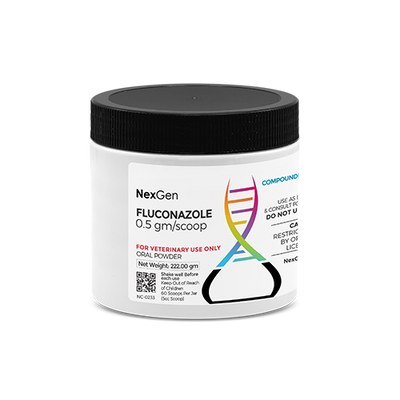
Fluconazole 2 gm/scoop, Oral Powder, 30 Scoops (9cc Scoop)
Login for pricing
- Brand
- NexGen
- SKU:
- NC-0235
- Product Type:
- Powder
- Size:
- 16oz
- Administration:
- Oral
- Scoops Per Container:
- 30
- Scoop Size:
- 9cc
Fungi are parasitic, spore-producing organisms which obtain their nourishment by absorbing food from the plant or animal hosts upon which they grow. Countless species of fungus abound in the environment, but only some are capable of causing disease. The primary source of most fungal infections is soil; these are usually acquired through inhalation, ingestion, or through the skin (e.g., via cuts or wounds).
Certain fungal infections can cause disease in otherwise healthy animals, while others require a host that is immunocompromised to establish infection. The prolonged use of antimicrobial drugs or immunosuppressive agents is believed to increase the likelihood of some fungal infections.1 Fungal infections may be localized, or they may affect the entire body.
A horse’s skin and coat are regularly exposed to numerous fungal organisms. Like bacterial and viral infections, horses can fall prey to fungal infection when they are immunocompromised by stress or other infections. Once established, some fungal organisms can produce significant infection under these conditions. Some, like ringworm, are more or less a nuisance, while others can range from irritating to life-threatening.
Horses suffering from other skin conditions like lice, or those in an environment with biting flies are also at risk for fungal infections, as well as horses housed in crowded, moist or unsanitary conditions. Skin abrasions, wounds, and even the friction of bridle irritation can place a horse at risk for mycotic (fungal) infection.1,2
Fungal Diseases Affecting Horses
Fungal infections in horses can be attributed to about 50 different species, hundreds of types, and thousands of subtypes of fungi.2 The respiratory system, surface of the skin and deep tissue can be targets of mycotic infection, as can the hair. While subcutaneous (e.g., pythiosis, mycetoma) and deep mycoses (e.g., blastomycosis, coccidioidomycosis) are considered rare and limited to restricted geographical areas, dermatophytosis, cryptococcosis and aspergillosis are of wider concern due their worldwide diffusion and (in some cases) their zoonotic potential.3
Subcutaneous and deep mycoses tend to be chronic, progressive diseases.1 Their clinical signs include extensive, painful lesions which can resemble other types of infection. Respiratory disease caused by fungal organisms is considered rare in horses however, there is a geographic correlation for disease development, with fungal respiratory infections seen more commonly by veterinarians working in tropical or subtropical environments.1,3
Fluconazole for Fungal Infections in the Horse
It is well-absorbed after oral administration, and its pharmacokinetics have been well-determined in horses. It is water soluble and minimally protein bound, distributes well in body tissues and fluids, and has a wide margin of safety.5 Fluconazole is considered especially useful in treating coccidioidomycosis, blastomycosis, and histoplasmosis. It is reported to have limited spectrum of activity against filamentous fungi (e.g., Aspergillus and Fusarium spp). In contrast to itraconazole, compounded fluconazole formulations are very stable.5
Where to buy Fluconazole
Fluconazole is available in the U.S. through pharmaceutical manufacturers and through veterinary custom compounding companies.
Fluconazole carries numerous potential drug interactions. Please consult your veterinarian prior to beginning any treatment regimen.
FOR RX ONLY: A valid prescription from a licensed veterinarian is required for dispensing this medication.
3Cafarchia C., et. al. Fungal diseases of horses. Vet Microbiol. 2013 Nov 29;167(1-2):215-34. doi: 10.1016/j.vetmic.2013.01.015. Epub 2013 Jan 29. PMID: 23428378.














